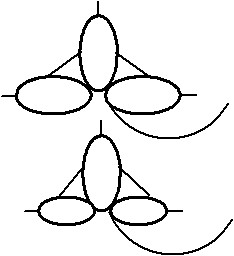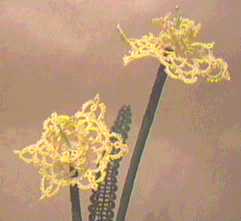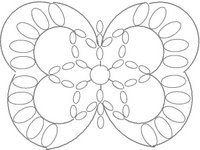I have how to tat demos on my web site which were done when the internet was new and it was important for files to be small. There have been other videos done since, but I don't think any of them have been filmed from the tatter's point of view.
I frequently receive e-mail from people asking for help and often the problem is that they haven't wrapped the thread around their hand properly. Having written the same thing a bunch of times, I now keep a spare How to Tat draft e-mail. So for your pleasure and benefit, here are detailed instructions that should really de-mystify the process.
HOW TO TATThere are several different methods of shuttle tatting, some of which are, the Riego method, the loop method and the traditional method. Each of these methods uses different motions to create the doublestitch that is used in all tatting. That can make it very confusing to a novice using more than one set ofreference material. The following instructions arefor the traditional method.
Double stitches (DS) are used to form rings (R)and chains (CH) and it is easiest to learn how to form the double stitches when working with 2 contrasting colours of size 10 thread. For example; red and white. Fill a shuttle with white thread, then knot the end of the white thread together with the ball of red thread.
Pinch the knot between the thumb and forefinger of the left hand. Take the red thread up and over the back of the fingers of the left hand, spreading the fingers a little, then secure the thread by wrapping it several times around the left baby finger. All of the action happens on the stretch of thread between the forefinger and middle finger of the left hand. So make sure there is enough room for the shuttle to pass between those 2 fingers. Let's call this part ofthe red thread the "action" thread.
Now take the shuttle in the right hand and with the hook, point or pick pointing forward, place the thumb on the bottom and the forefinger or first 2 fingers of the right hand on the top. Use the last 3 fingers of the right hand to hold the shuttle thread up and out of the way when forming the first half of the doublestitch.
The shuttle is used to manoeuvre the shuttle thread around the "action" thread that is over the left hand. For the first half of the doublestitch, lift the shuttle thread up and out of the way. Spread the fingers of the left hand to keep the red thread tight. Slide the shuttle under the "action" thread.Don't let go of the shuttle, just let the red thread slip between the shuttle and the fingers, off the back of the shuttle and then pull the shuttle back out, letting the thread slip between the shuttle and the thumb.
Note that the shuttle is below both the shuttle thread and the "action" thread when you slide it under, but between the threads when you slide the shuttle out. That forms the first half of the stitch using the white shuttle thread.
Now to flip the stitch over to the red thread relax the left hand and pull the shuttle straight out to the right keeping the white thread tight. Alternating which thread is being held tight is what flips the stitch. Then extend the fingers of the left hand again to tighten the red thread and use the middle finger of the left hand to slide the first half of the stitch over until it's right against the knot that you are pinching. That's the first half done.
For the second half of the stitch again keep the red thread tight. Let the shuttle thread hang down in front of the "action" thread. Take the shuttle OVER the "action" thread and slide it butt end first underthe "action" thread and let the red thread slip between the shuttle and the forefinger.
Note that the shuttle is above both the shuttle thread and the "action" thread as you go over it, but between the threads as you pull the shuttle out. Again relax the fingers of the left hand and pull the shuttle straight out to the right. Keep the white shuttle thread tight, then extend the fingers of the left hand again using the middle finger to slide the second half of the stitch against the first half.That's the doublestitch completed.
Repeat until you have the specified number of stitches completed. You will see that all of the stitches are red - the colour of the thread over the back of the left hand. You can tell immediately that any stitches which are not red are not flipped.
Picots are created simply by leaving a little extra thread between stitches. When the stitches are slid together the extra thread makes a loop that is a picot. The more thread between the stitches, the bigger and lacier the picot will be.
Chains are created using both a shuttle thread and a chain or ball thread. Rings are created using only the shuttle thread. To tat a ring pinch the end of the shuttle thread. Wrap the thread up over the back of the fingers of the left hand as you did for the chain, but instead of winding it around the baby finger, bring the thread across the palm and pinch it again. You will have a complete circle around the fingers when tatting a ring. The formation of the stitches is identical to the chain. When you have completed the ring pull on the shuttle thread and the ring should slide closed. If the ring doesn't close then one or more stitches aren't flipped.
Usually you reverse work - turn the work upside down - when you switch from rings to chains and from chains to ring.
Rings and chains are joined to one another through the picots. Shuttles that have a hook on the front are more efficient for joins. Insert the hook into the picot and pull up a loop of "working" thread, then slide the shuttle through the loop. Use the fingers of the left hand to pull the loop back down trapping the shuttle thread underneath. Make sure that the shuttle thread still slides after the join. It is easier to check as you are working than to have to un-tat.
Older patterns are written in long form but newer patterns use visual diagrams where the circles or ovals represent rings, the arced lines represent chains and the short little lines or sometimes tiny loops represent picots. A join is indicated by a short line touching any two parts like two rings or two chains. The numbers shown around the outside of a ring represent the number of doublestitches to be tatted for each section of the ring.
For example a visual diagram of a ring might show an oval with a short line on each side and one on the top. If there was a number 7 above and another 7 below the short line on the left and two more 7's on the left. You would tat 7 doublestitches, leave a picot space, doing that 3 times then tat 7 more doublestitches before pulling on the shuttle thread to close the ring. The number of doublestitches required for each segment of a chain is usually shown alongside the chain.
Sometimes three rings are joined together forming a cloverleaf or trefoil. To form a cloverleaf, tat the first ring, do not reverse work. Tat the second ring, starting it as close to the first ring as possible leaving no gaps. Join it to the side of the first ring. Do not reverse work and tat the third ring close to the previous ring again joining the rings at the side. After all three rings are completed, reverse work to tat the chain.
A good diagram should let you visualize the finished lace even if you don't have a picture, but a picture always helps.


































 Here's the pattern for the first one and in case you can't read the stitch count everything is 3. Knowing where I started from, can you figure out the pattern for the next one? Experienced designers would laugh at the question, but if you haven't designed before, see if you can. Many times I have created a new design because I just made a mistake in reading a pattern. Designing isn't hard, but like tatting, it takes practice. This is a very forgiving design that's really hard to mess up, so it's a good piece to start with. And you know what? I'm still doing variations of this same design.
Here's the pattern for the first one and in case you can't read the stitch count everything is 3. Knowing where I started from, can you figure out the pattern for the next one? Experienced designers would laugh at the question, but if you haven't designed before, see if you can. Many times I have created a new design because I just made a mistake in reading a pattern. Designing isn't hard, but like tatting, it takes practice. This is a very forgiving design that's really hard to mess up, so it's a good piece to start with. And you know what? I'm still doing variations of this same design.


